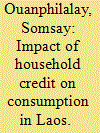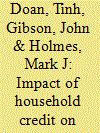| Srl | Item |
| 1 |
ID:
154536


|
|
|
|
|
| Summary/Abstract |
This study evaluates the impact of credit on consumption in Laos. A two-stage selection bias correction method based on a multinomial logit framework is used to estimate and compare the consumption of borrowing households with and without credit. The results show that compared to what household consumption would have been without credit, borrowing households tend to have higher overall consumption. However, when consumption is disaggregated into food and nonfood, it is found that only formal credit has a positive impact on food spending. Borrowing from semiformal sources and informal sources without interest has a negative impact on food spending. For nonfood consumption, the impact of credit is found to be positive and statistically significant for all credit sources.
|
|
|
|
|
|
|
|
|
|
|
|
|
|
|
|
| 2 |
ID:
130054


|
|
|
|
|
| Publication |
2014.
|
| Summary/Abstract |
There is an ongoing debate about whether microfinance has a positive impact on education and health for borrowing households in developing countries. To understand this debate, we use a survey designed to meet the conditions for propensity score matching (PSM) and examine the impact of household credit on education and healthcare spending by the poor in peri-urban areas of Ho Chi Minh City, Vietnam. In addition to matching statistically identical non-borrowers to borrowers, our estimates also control for household pre-treatment income and assets, which may be associated with unobservable factors affecting both credit participation and the outcomes of interest. The PSM estimates show a significant and positive impact of borrowing on education and healthcare spending. However, further investigation of the effects of the treatment reveals that only formal credit has a significant and positive impact on education and healthcare spending, while informal credit has an insignificant impact on spending. This paper contributes to the limited literature on peri-urban areas using evidence from one of the largest and most dynamic cities in Southeast Asia.
|
|
|
|
|
|
|
|
|
|
|
|
|
|
|
|